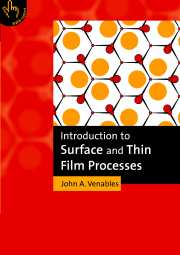Book contents
- Frontmatter
- Contents
- Preface
- Chapter 1 Introduction to surface processes
- Chapter 2 Surfaces in vacuum: ultra-high vacuum techniques and processes
- Chapter 3 Electron-based techniques for examining surface and thin film processes
- Chapter 4 Surface processes in adsorption
- Chapter 5 Surface processes in epitaxial growth
- Chapter 6 Electronic structure and emission processes at metallic surfaces
- Chapter 7 Semiconductor surfaces and interfaces
- Chapter 8 Surface processes in thin film devices
- Chapter 9 Postscript – where do we go from here?
- Appendix A Bibliography
- Appendix B List of acronyms
- Appendix C Units and conversion factors
- Appendix D Resources on the web or CD-ROM
- Appendix E Useful thermodynamic relationships
- Appendix F Conductances and pumping speeds, C and S
- Appendix G Materials for use in ultra-high vacuum
- Appendix H UHV component cleaning procedures
- Appendix J An outline of local density methods
- Appendix K An outline of tight binding models
- References
- Index
Preface
Published online by Cambridge University Press: 06 July 2010
- Frontmatter
- Contents
- Preface
- Chapter 1 Introduction to surface processes
- Chapter 2 Surfaces in vacuum: ultra-high vacuum techniques and processes
- Chapter 3 Electron-based techniques for examining surface and thin film processes
- Chapter 4 Surface processes in adsorption
- Chapter 5 Surface processes in epitaxial growth
- Chapter 6 Electronic structure and emission processes at metallic surfaces
- Chapter 7 Semiconductor surfaces and interfaces
- Chapter 8 Surface processes in thin film devices
- Chapter 9 Postscript – where do we go from here?
- Appendix A Bibliography
- Appendix B List of acronyms
- Appendix C Units and conversion factors
- Appendix D Resources on the web or CD-ROM
- Appendix E Useful thermodynamic relationships
- Appendix F Conductances and pumping speeds, C and S
- Appendix G Materials for use in ultra-high vacuum
- Appendix H UHV component cleaning procedures
- Appendix J An outline of local density methods
- Appendix K An outline of tight binding models
- References
- Index
Summary
This book is about processes that occur at surfaces and in thin films; it is based on teaching and research over a number of years. Many of the experimental techniques used to produce clean surfaces, and to study the structure and composition of solid surfaces, have been around for about a generation. Over the same period, we have also seen unprecedented advances in our ability to study materials in general, and on a microscopic scale in particular, largely due to the development and availability of many new types of powerful microscope.
The combination of these two fields, studying and manipulating clean surfaces on a microscopic scale, has become important more recently. This combination allows us to study what happens in the production and operation of an increasing number of technologically important devices and processes, at all length scales down to the atomic level. Device structures used in computers are now so small that they can be seen only with high resolution scanning and transmission electron microscopes. Device preparation techniques must be performed reproducibly, on clean surfaces under clean room conditions. Ever more elegant schemes are proposed for using catalytic chemical reactions at surfaces, to refine our raw products, for chemical sensors, to protect surfaces against the weather and to dispose of environmental waste. Spectacular advances in experimental technique now allow us to observe atoms, and the motion of individual atoms on surfaces, with amazing clarity. Under special circumstances, we can move them around to create artificial atomic-level assemblies, and study their properties.
- Type
- Chapter
- Information
- Introduction to Surface and Thin Film Processes , pp. xi - xviPublisher: Cambridge University PressPrint publication year: 2000

